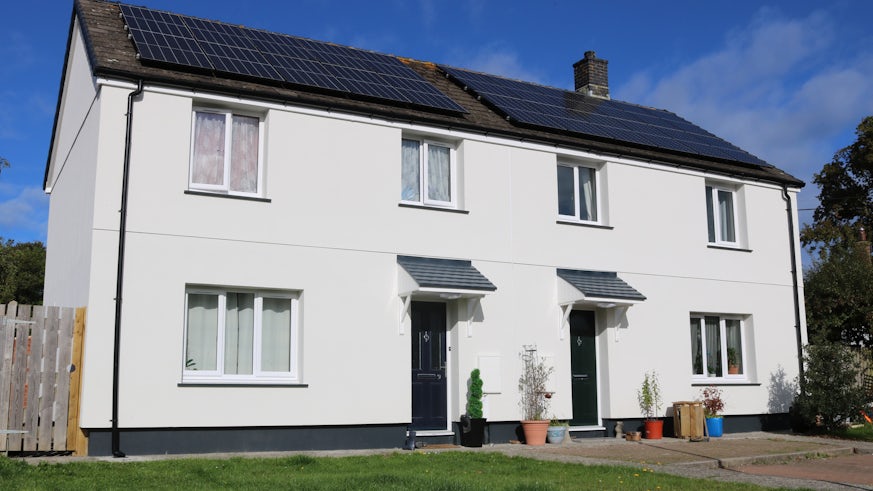Fit for the future: remodelling homes to push beyond net zero
1 September 2023

Researchers from across the GW4 Alliance of Bath, Bristol, Cardiff and Exeter universities will work with industry, community groups and local authorities to transform existing housing into ‘Beyond Net Zero’ liveable homes, as part of UK Research and Innovation’s (UKRI) Green Transition Ecosystem awards.
The team will design, test, implement and monitor innovative prototype bio-based lower carbon solutions to improve the energy efficiency and resilience of homes, and evaluate their performance compared to traditional synthetic materials.
The goal is to create scalable and transferable designs and solutions to retrofit a greater number of houses and different house types.
The housing sector is responsible for around 20% of the UK’s total carbon emissions and with 80% of the homes that will be occupied in 2050 already built, retrofitting the country's existing housing stock to improve energy efficiency, and reduce carbon emissions, is critical to achieving the UK's net zero targets.
Project lead Professor Pete Walker of the University of Bath said: “It is not enough to simply implement design solutions; we need to create comfortable liveable homes that are resilient to climate change and will withstand future weather events. Our design process will embed community participation at its centre by creating spaces for co-developing knowledge, sharing experiences, and reshaping designs for Beyond Net Zero homes.”
The UK Government is investing billions to improve the energy efficiency of homes across the country, including through measures such as insulation.
However, retrofitting can be a design challenge. Poorly executed retrofit measures can lead to problems with damp and mould, and poor design can cause damage to building fabric and cultural heritage.
Current retrofitting approaches rely heavily on synthetic and non-renewable materials, such as plastics and foam insulation, which can have negative environmental impacts. In some cases, the embodied carbon emissions of retrofitting measures can exceed the carbon savings from reduced energy use.
“Our innovative solutions will use bio-based and non-extractive materials together with renewable energy supply and storage. We will explore the impact of these materials not only on achieving net zero design but also the potential impact on residents' comfort and wellbeing.”
The interdisciplinary nature of the project brings together expertise from architecture, engineering, social sciences, and sustainability and will work with a range of partners including Woodknowledge Wales, The Alliance for Sustainable Building Products, Mikhail Riches Architect, timber frame manufactures Sevenoaks Modular Limited, Swansea Council and WeCanMake, a community land trust based in Bristol.
Project co-director Professor Jo Patterson of Cardiff University’s Welsh School of Architecture, said: “This project evolved from a GW4 research community, and would not have been possible without the support of the GW4 Alliance.

“I am excited to be part of a team that will expand on that research, working with colleagues across the alliance and alongside new regional partners to transform existing housing by working with, and for, communities.”
The project team will communicate their research findings through educational and wider community engagement, in partnership with the Future Observatory, and will develop and deliver training to reduce the design skills gap in retrofitting.
Minister for Energy Efficiency and Green Finance Lord Callanan said: “Today’s £4.6 million funds – backed with Government funding – will be a key contribution towards helping cut emissions and making homes more energy efficient.
“By testing different renewable resources to help keep homes warm and save households money on their energy bills, this project will further support our ambition to cut energy demand by 15% by 2030. And by working closely with communities, the project will also help ensure that local views and experiences are front and centre in our transition to a cleaner, more secure energy system.”
Councillor Andrea Lewis, Cabinet member for Service Transformation at Swansea Council, added: “Swansea Council is proud to continue our long-standing working relationship with Cardiff University’s Welsh School of Architecture, and the wider research team from the GW4 consortium.
“We are pleased to be part of this exciting new research project, which will give us the opportunity to work closely with leading academics and industry experts to provide us with a greater understanding of innovative ways to retro fit our existing stock of council homes to reduce energy and carbon emissions, and help our tenants reduce the cost of their energy bills and improving comfort and health and wellbeing.”
Green Transition Ecosystems (GTEs) are large-scale projects that focus on translating the best design-led research into real-world benefits. Capitalising on clusters of design excellence, GTEs will address distinct challenges posed by the climate crisis including, but not limited to, realising net zero goals.
GTEs are the flagship funding strand of the £25 million Future Observatory: Design the Green Transition programme, the largest publicly funded design research and innovation programme in the UK.
Funded by AHRC with support from the UK Government and in partnership with Future Observatory at the Design Museum, this multimodal investment aims to bring design researchers, universities, and businesses together to catalyse the transition to net zero and a green economy.
Share this story
The distinctiveness of the School lies in its tradition of combining creativity with a focus on making, ìts research portfolio, the calibre of its staff and unique location.



